The Old Republic preview
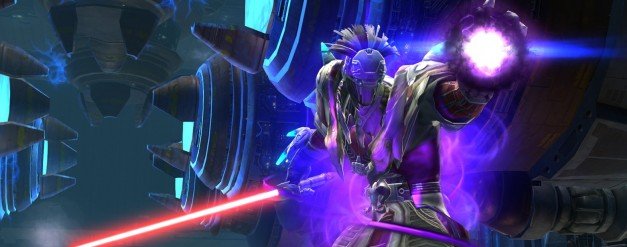
The thing you sometimes forget about The Old Republic is that it's a Star Wars game; that it's the sum product of tens of millions of massively multiplayer dreams. Play Star Wars. Be a hero. Do it with your friends.
The other thing you forget? That BioWare are good at making Star Wars games. Knights of the Old Republic is one of the great RPGs. TOR is more of that, except rather than play as a fledgling Jedi knight, you also get to play as a fledgling smuggler, fledgling Imperial agent, fledgling bounty hunter...
I've played The Old Republic at trade shows and at press events multiple times, and always come away impressed. But I'd never had the chance to disappear into the game properly. Here, with no distractions, I simply vanished into it. In six hours, I burned through from level one to level ten, barely looking up. It was a brilliant, brilliant experience – polished, flowing, with quests that smartly escalate and a story well told.
I've been levelling a smuggler character through TOR's opening area of Ord Mantell and beyond. The smuggler class is meant to be Han Solo incarnate – a character archetype who relies on chucking grenades, blaster fire and barbed wit at the enemy.
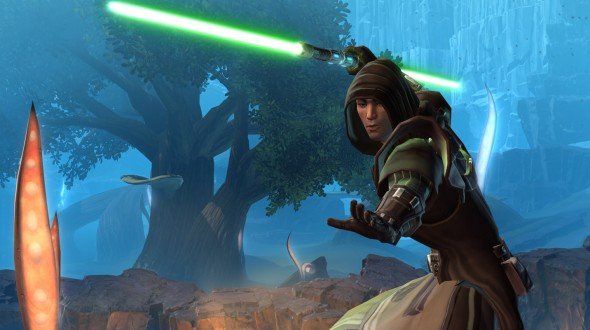
The smuggler is at his best when firing from behind cover. You tap a hotkey to roll into safety, and then pop up from behind to pelt an attacker with fire. It doesn't feel particularly heroic, but that's kind of the point – smugglers don't like getting into fist fights. Slightly later you're given a couple of comic finishing moves – you can kick an enemy in the balls, and then smack them over the head with the butt of your blaster. I didn't check if this works with droids.
I was surprised at the flexibility available in TOR's character selection – there are far more examples of body types, haircuts, beards and random facial accruements than I'm used to in WoW, say. I was so surprised by just how fat your character can be, I've hereby vowed that every character in my menagerie will be artfully modelled on a lardier version of the Pillsbury Doughboy. Even the ladies.
The smuggler's storyline begins on Ord Mantell. His ship and cargo are stolen; he's stranded planetside, with the local crime lord chasing him for payment. Meanwhile, Separatists and the Republic are at war: even if he had a ship, he's not going to get past the blockade. The quests start with small tasks for the local civilians and downand- outs. Retrieve a family heirloom from a village. Find the missing son of two local refugees. Get a doctor to come back and administer aid to the local Republic forces. Capture a pirate. Infiltrate a Separatist base.
The biggest gaming news, reviews and hardware deals
Keep up to date with the most important stories and the best deals, as picked by the PC Gamer team.
The opening area is essentially an island. Quests send you to the north first, then the east, and finally the west. Quest goals are marked clearly on the map, any area transitions that you have to progress through shown with a bright green arrow. Along the way, you come across small subquests that can be completed in the local area. You're never directly offered pure grind quests – no 'kill ten Womp Rats'. As you move through an area, you'll be given a running counter that will offer a further reward as you progress.
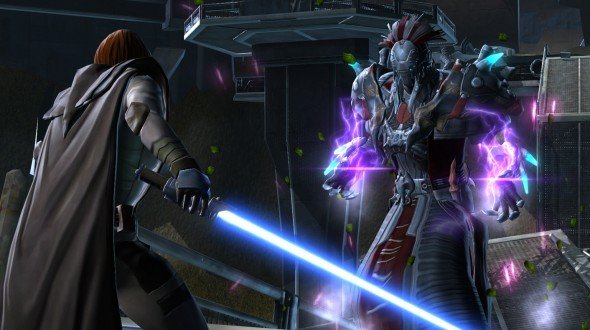
When fighting in a Separatist base, I was offered an XP reward for killing 15 soldiers. It didn't matter what creed or colour, or what weapon they were carrying, as long as they died as part of completing my other objectives. This is very, very smart thinking – turning the expectation of grind into what's essentially a really achievable… uh, achievement.
There are other clever interpretations of MMO mechanics. The opening settlement includes vendors of level-appropriate gear – in this case a blue chest-piece. This gear can be bought for commendations – currency earned for completing quests. By the time I reached level nine, I had enough. Extra commendations for a new blue waistcoat. Nice.
There was a similarly pleasant mechanical moment as I transitioned from one quest area to the next. My new companion (more on these guys later) warned me of the dangers that lay ahead. “Here,” he said, “take this”, offering his prized, heavily modified pistol.
Combat surprised me. When you're levelling in WoW, you're usually peeling off single baddies from groups, dealing with them one by one. You're careful to watch for patrols, and if you get ambushed by more than one, you'll probably have to quaff a health potion or blow a cooldown. Most monsters have one or two abilities that they spam. You'll die if you take on more than two mobs. In The Old Republic, the default combat scenario is to face three or more linked enemies.
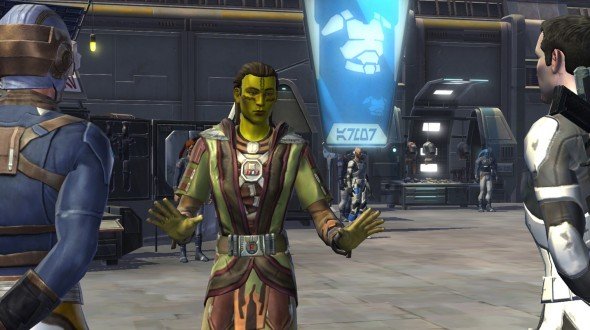
Aggro one, and they'll all activate. That means planning where your crowd control is going to hit, and in what order you're going to attack. At first, this sounds like combat is going to be harder, but it's not. Their health pools are pretty small, and they go down very quickly. Each combat area, be it an underground base or overworld setting, is also much larger than those found in “insert generic MMO here” – and the pulls are all widely separated. The theoretical downside: much more wandering. That didn't bother me. The upside is massive: you just don't die from monsters respawning and then wandering into your back. I have no idea how this will play out at launch, when millions of players will be caning quests, burning through the opening areas in a few hours – but in my normal play session, levelling was a real pleasure.
There are serious quality of life improvements for MMO players. First: death is painless. If you die, you can respawn in situ by calling in a medical bot. You'll then have a few seconds of immunity to find a safe location. All players seem to be able to resurrect other players out of combat freely, from level one. The smuggler includes a recuperation ability that lets him recover health and action points in a very short space of time. And, finally, companion characters can be sent back to town to sell any junk items – like Torchlight's pet cats and dogs.
The Old Republic might not be the first to introduce these ideas, but I'm convinced everything listed above will be adopted by all MMOs going forward. They just make sense, ensuring your time in-game is spent playing, not fiddling.
It makes sense, because your time in The Old Republic feels meaningful. In practice, there's very little separating what you do in the Old Republic MMO and what you do in the Knights of the Old Republic singleplayer game: find a guy, have a bit of dialogue, and then go out into the world to kill stuff. You just do it with your friends, and see other players running around.
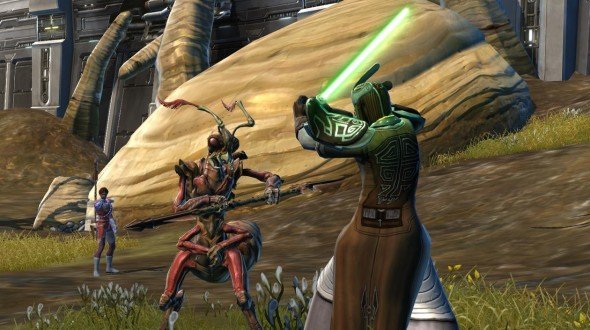
I wondered how dialogue and conversation would work in practice: BioWare's solution is pretty smart. If you're about to have a story moment, you'll pass through a glowing green forcefield – creating a separate instance of the game for you and your party. In there, you might fight a baddie, or talk to an NPC, but you'll do it isolated from other players. All quests are introduced by dialogue and a cutscene, and when you're talking to a quest-giver, the rest of the world will see a little speech bubble over your head.
Most quests begin and end with a small or major decision. When one doctor wouldn't tell me where to find vital supplies, I threatened her kid. That helped, at the cost of 50 dark side points. When asked, in the course of invading a Separatist stronghold, to release a pirate prisoner, and an obviously bad man, I could choose to leave him in there, kill him, or release him – with consequences to my moral standing, and, I hope, the chance to meet the Greedo lookalike down the line.
By level six, I was cruising through the open world quests and met my first real challenge: a heroic zone. Heroics are areas designed for grouping, with harder monsters and better rewards. Even on the limited test server I was playing on, it was extremely easy to find a companion to play with. It took around 20 minutes to complete the quests – and the loot was a cut above what I was expecting. The only weirdness: seeing my fellow smuggler wander around with the same companion.
Traditionally, MMO questing is a singleplayer experience, but it gets better, and faster, if you do it in pairs. Playing in a pair means you can take on more mobs, and cruise through more quests, faster. Two organised players seem to complete quests at triple the clip of a solo player. TOR's solution: give every player a pet AI to quest alongside. The smuggler's first companion is a long-range sniper – but he can equip the same weapons and armour that you wear or use. In cutscenes, he'll offer comments, and the conversations you'll have bounce between the target, your companion, and your player character.
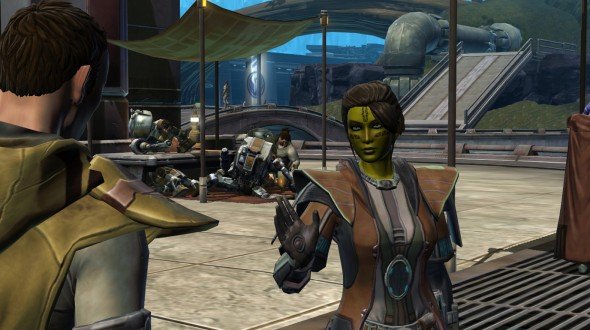
In questing, I soon discovered that the companion was a useful friend. By level seven I'd perfected a rotation of abilities that could tear through mobs. First, throw an explosive pack at an enemy that will detonate if the target receives damage. Then throw a frag grenade for area of effect damage. Then a flash grenade for AOE stuff. Fire one shot at the first target to take him out. My companion would then grapple hook a weak mob over to us, where I could kick them in the balls, and smack them with the upside of my pistol. To end, focus fire on the final target.
The heroic area was a warm-up for an impressive climax – a separatist base dug into the side of a hollowed-out volcano. This was, essentially, a public dungeon – with multiple quest objectives coinciding. It's where my smuggler discovered the fate of his ship and the lost cargo of blasters.
This is where BioWare's experience with Star Wars pays off. TOR offers the same moral duality that we saw in Knights. You're meant to be fighting for the Republic as a smuggler, but the game goes out of its way to portray the Republic as corrupt, narcissistic and morally bankrupt. It makes a point of appalling you.
This is why, I believe, The Old Republic will succeed. I'm never going to claim that it will offer Witcher 2 levels of choice and moral flexibility. But it's doing as much as the old Knights games, in a world in which you can play with your friends. Its design includes elements that drive all MMO developers to do better work. And it does it all within the world's most popular universe.
The Old Republic is a monster. I can't wait to play more.

